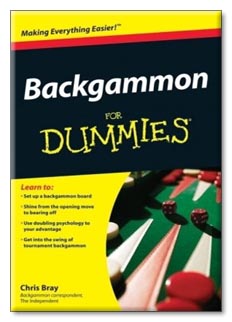Introduction
About This Book
Conventions Used in This Book
Foolish Assumptions
How This Book is Organised
Icons Used in This Book
Where to Go from Here
Part I: Starting and Playing the Game
Chapter 1: Tackling the Basics of Backgammon
Looking at the Basics of the Game
Setting Up the Board and Arranging the Pieces
Examining the Rest of the Equipment
Dice
Dice shakers or dice cups
Doubling cube
Digging into the Underlying Concepts
Making use of arithmetic
Practising pattern recognition
Being mindful of psychology
Combining Three Parts into a Whole Game
Choosing among the Different Ways to Play the Game
Wagering one-on-one
Entering the chouette
Chapter 2: Playing the Game
Rolling the Dice
Agreeing on the Notation
Indicating the roll of the dice
Numbering the points on the board
Showing how the checkers move
Moving the Checkers
Starting the game
Making the moves
Hitting and re-entering
Bearing off
Chapter 3: Looking at Basic Backgammon Tactics
Understanding Dice and Numbers
Reading a dice table
Using the dice table
Starting Out with the Fundamentals
Making points
Building primes
Hitting your opponent's checkers
Choosing Your Move
Indentifying candidate plays
Selecting the best play
Chapter 4: Making the Opening Move
Understanding Opening Objectives
Defining the objectives
Introducing risk
Winning the Roll and Making the First Move
Starting with the best
Handling other opening moves
Responding to the Opening Move
Destroying a slot
Gaining tempo with a hit
Changing Priorities
Dealing with Doubles
Part II: Handling the Middle Game
Chapter 5: Upping the Stakes by Doubling
Understanding the Basics of Doubling
Introducing the doubling cube and counting by doubles
Presenting the procedure
Estimating Your Chances
Counting pips to see who's ahead
Applying the 25 per cent rule
Improving your odds by owning the cube
Answer the Three Key Questions about Doubling
Offering a double
Looking at end-game doubling decisions
Remembering Reference Positions
Chapter 6: Progressing to Advanced Doubling
Good Principles Make Good Doubles
Checking your position in the race
Inspecting your structure
Evaluating threats
Putting the principles into practice
Judging Volatility and Looking for Market Losers
Accommodating Gammons
Applying Psychology
Steaming
Freezing
Playing the opponent
Redoubling Quandary: When Is Your Position Too Good?
Chapter 7: Planning Tactics for the Middle Game
Having a Plan
Demonstrating Basic Middle Game Tactics
Diversifying your good numbers
Duplicating your opponent's good numbers
Picking and passing
Priming and attacking
Paying now or paying later
Chapter 8: Discovering Strategies
Racing toward the Finish
Bearing into your home board
Holding Position in Anchor Games
Playing holding games
Anchoring on the 4-point
Trying an anchor on the 3-point
Avoiding the smaller anchors
Braving a Blitzing Game
Blitzing early
Blitzing in the middle game
Going Prime Versus Prime
Sorting out a strategy
Moving with zugzwang
Playing Back Games with Anchors
Part III: Bearing Off (The Last Lap)
Chapter 9: Bearing Off without Contact
Assessing No-miss Positions
Using Robertie's Addition Method
Counting on the 8-9-12 Formula
Chapter 10: Bearing Off Against Contact
Bearing Off when Your Opponent is on the Bar
Getting them home
Getting them off
Staying Afloat with an Anchor in Your Home Board
Navigating the ace-point game
Doubling the Weight with Two Anchors
Killing numbers
Checking your numbers
Part IV: Varying the Play
Chapter 11: Looking at Complex Endings
Winning after Hitting a Late Shot
Building a prime
Rolling home a prime
Bearing off to victory
Becoming Aggressive under Duress
Meeting the Coup Classique
Setting the scene
Executing the coup
Weighing Anchors
Pulling out too soon
Trapping off an anchor
Chapter 12: Entering the Chouette
Listing the Reasons to Play in Chouettes
Examining the Players and the Play
Introducing the players
Explaining the play
Doubling in a chouette
Developing Chouette Tactics
Accommodating weak players
Playing in the box
Playing on the team
Checking your Bank Balance before Joining a Chouette
Chapter 13: Playing Tournament Backgammon
Introducing Tournament Play
Paying to play
Scoring the play
Playing with a clock
Following the Rules about Doubling
Doing without doubling: The Crawford Rule
Earning a free drop
Making automatic redoubles
Strategising Match Play Tactics
Getting to know your opponent
Adapting your opening moves
Concerning gammons
Playing to the Score with Match Equity Tables
Explaining a match equity table
Calculating match equity tables
Applying match equity tables
Nearing the end
Chapter 14: Using Computers and Online Play
Playing Against Computers
Mousing to move
Finding your level
Taking hints
Going for analysis
Venturing Online
Watching others
Paying the rake
Playing at speed
Chatting
Cheating
Playing Online
Choosing a site
Choosing a stake
Choosing an opponent
Varying your tactics online
Part V: The Part of Tens
Chapter 15: The Ten Commandments of Backgammon
Thou shalt Love the Game Above All Others
and Have no Other Game but Backgammon
Thou shalt Follow the Words of the Expert Magriel
Thou shalt do Thy Sums
Thou shalt Hit in the Openings
Thou shalt not Kill (the Checkers)
Thou shalt not Take a Kife to a Gunfight
Thou shalt Remember that Every Roll is a Doubling Decision
Thou shalt Use the Proper Tools to Evaluate Thy Doubling
Decisions
Thou shalt not Play on Automatic
Thou shalt Study and Play both Humans and Bots
Chapter 16: Ten Useful Backgammon Resources
Top Ten Books
Online Supply Sources
Auction Websites
Flint Area Backgammon News
Chicago Point
Backgammon Software
Online Playing Sites
BIBA
Gammon Village
Backgammon Galore
Index
| 
















